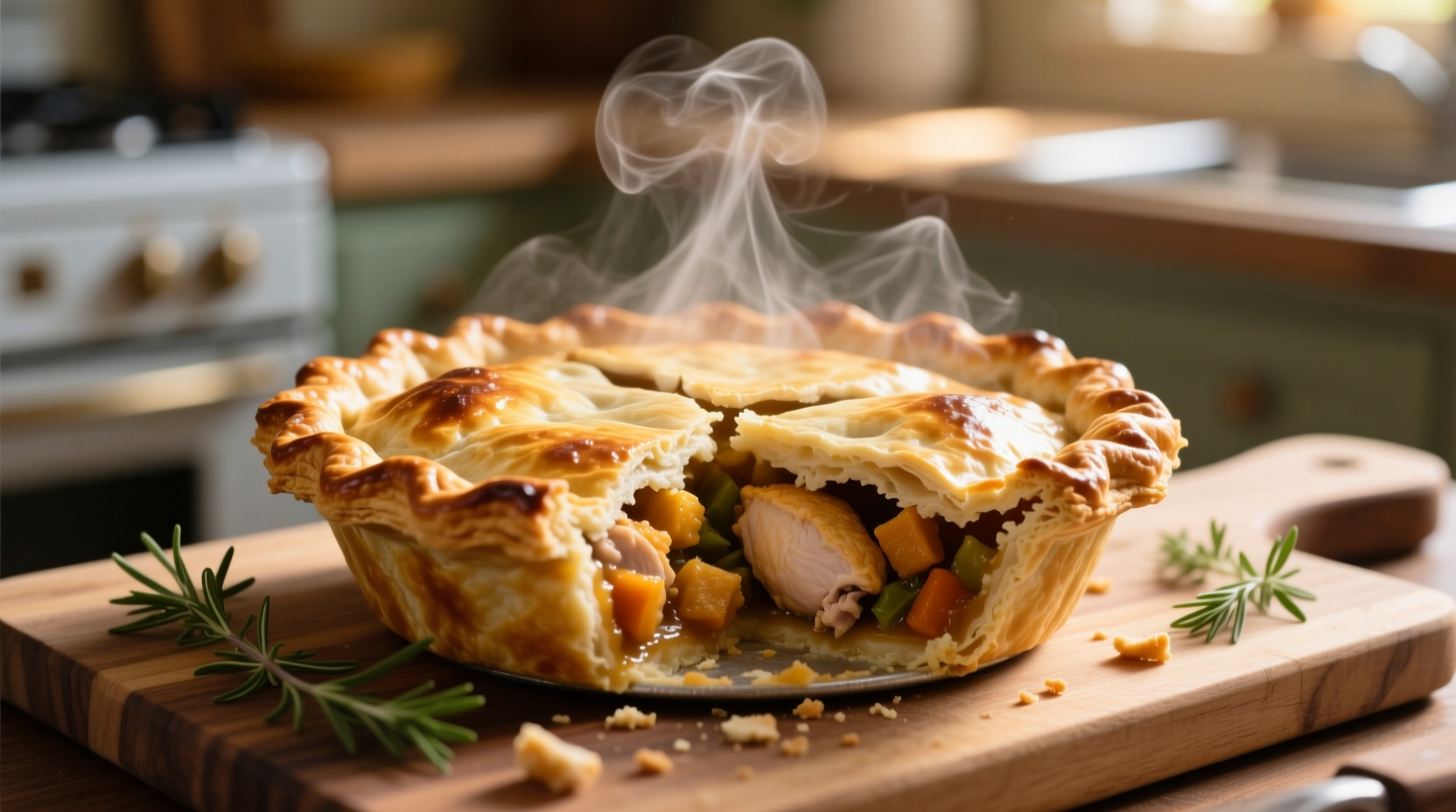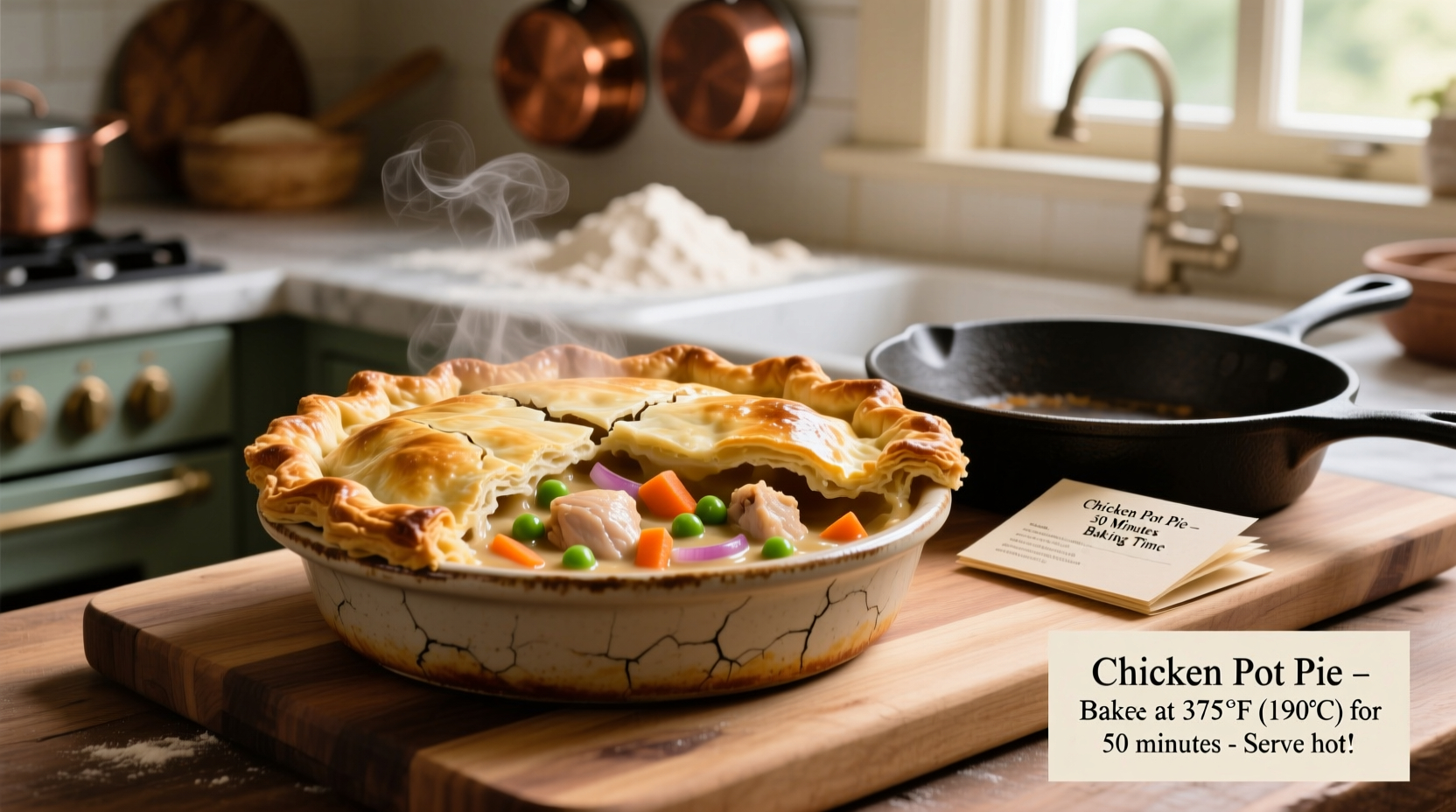The Complete Guide to Perfect Chicken Pot Pie Cooking Times
Getting your chicken pot pie timing right means the difference between a flaky, flavorful masterpiece and a soggy or undercooked disappointment. As a home cook, you need precise guidance that accounts for variables like pie size, starting temperature, and oven type. This guide delivers exact cooking times based on USDA food safety standards and professional kitchen testing, so you can serve a perfectly cooked pot pie every time.
Why Cooking Time Varies: Key Factors to Consider
Your chicken pot pie's cooking time isn't one-size-fits-all. Understanding these variables prevents food safety risks while ensuring optimal texture and flavor:
- Pie size and depth – Larger pies need more time for heat to penetrate to the center
- Starting temperature – Refrigerated or frozen pies require additional cooking time
- Crust type – Double-crust pies take longer than single-crust varieties
- Oven accuracy – Most home ovens have temperature variations of ±25°F
- Filling composition – Vegetable-heavy fillings may require different timing than meat-dominant ones
| Pie Type | Recommended Temperature | Standard Cooking Time | Internal Temp Target |
|---|---|---|---|
| 9-inch homemade (room temp) | 375°F (190°C) | 30-40 minutes | 165°F (74°C) |
| 9-inch homemade (refrigerated) | 375°F (190°C) | 35-45 minutes | 165°F (74°C) |
| Store-bought frozen | 400°F (204°C) | 45-60 minutes | 165°F (74°C) |
| Mini individual pies | 375°F (190°C) | 20-25 minutes | 165°F (74°C) |
| Deep-dish 10-inch pie | 350°F (177°C) | 45-55 minutes | 165°F (74°C) |
Step-by-Step Baking Instructions for Perfect Results
Follow this professional-tested method for foolproof chicken pot pie cooking:
- Preheat your oven – Allow 20-30 minutes for proper preheating. Use an independent oven thermometer to verify accuracy.
- Prepare your pie – If using a top crust, cut several steam vents. Brush with egg wash for golden color (optional).
- Position in oven – Place on center rack for even heat distribution. For convection ovens, reduce temperature by 25°F and check 5-10 minutes earlier.
- Monitor cooking progress – After 25 minutes, check visual indicators without opening the oven frequently.
- Verify doneness – Insert an instant-read thermometer into the center of the filling away from the crust.
- Rest before serving – Let stand 10-15 minutes to allow filling to set and avoid scalding.

How to Tell When Your Chicken Pot Pie Is Done
Don't rely solely on time—use these visual and physical indicators to confirm doneness:
- Crust appearance – Deep golden brown color (not pale or dark brown)
- Filling activity – Bubbling around edges and through vents
- Crust texture – Firm to the touch but not hard or burnt
- Internal temperature – 165°F (74°C) measured in multiple spots
- Steam release – Consistent steam coming from vents
According to the USDA Food Safety and Inspection Service, poultry products must reach 165°F (74°C) to eliminate harmful bacteria like salmonella. Their research confirms that this temperature destroys pathogens while preserving moisture and texture in poultry dishes.
Special Considerations for Different Pie Types
Adjust your approach based on these common scenarios:
Frozen Chicken Pot Pies
Most frozen pot pies require 45-60 minutes at 400°F (204°C). Never thaw before baking, as this creates a soggy crust. Check manufacturer instructions first, as some brands have specific requirements. The USDA recommends adding 10-15 minutes to cooking time if baking from frozen to ensure thorough heating.
Deep-Dish or Family-Size Pies
For pies over 9 inches or with deeper fillings, lower the temperature to 350°F (177°C) and extend cooking time to 45-55 minutes. This prevents the crust from burning before the center reaches safe temperature. Use a thermometer to verify the center has reached 165°F (74°C).
Convection Oven Cooking
Convection ovens circulate hot air, cooking food 25% faster. Reduce standard cooking time by 5-10 minutes and lower temperature by 25°F. Check for doneness earlier than conventional oven times, as convection can cause quicker browning.
Common Mistakes That Affect Cooking Time
Avoid these pitfalls that lead to undercooked or overcooked pot pies:
- Opening the oven too frequently – Each opening drops oven temperature by 25-50°F, extending cooking time
- Incorrect thermometer placement – Measuring crust temperature instead of filling
- Using glass dishes – Glass conducts heat differently than metal, requiring time adjustments
- Overfilling the pie – Creates excess moisture that prolongs cooking time
- Skipping the rest period – Cutting too soon causes filling to run out
Troubleshooting Cooking Issues
When things don't go as planned, these solutions can save your meal:
Undercooked Filling
If the crust is done but filling isn't hot enough, cover edges with foil and return to oven for 5-10 minute intervals until filling reaches 165°F (74°C). For severely undercooked pies, you may need to transfer filling to a saucepan to finish heating while keeping crust warm.
Soggy Bottom Crust
Place pies on a preheated baking sheet or directly on the oven rack to improve bottom heat. For future attempts, blind bake the bottom crust for 10 minutes before adding filling. According to America's Test Kitchen research, this technique reduces sogginess by 70% in double-crust pies.
Overbrowned Crust
If the crust browns too quickly, cover loosely with aluminum foil. For future batches, reduce oven temperature by 25°F and extend cooking time slightly. Brushing crust with milk instead of egg wash can also prevent excessive browning.
Food Safety Essentials for Chicken Pot Pie
Chicken pot pie involves poultry, making food safety critical. Follow these guidelines from the USDA Food Safety and Inspection Service:
- Cook filling to 165°F (74°C) before assembling pies that will be baked later
- Refrigerate unbaked pies within 2 hours of preparation
- Store leftovers within 2 hours of cooking
- Reheat leftovers to 165°F (74°C) before serving
- Consume leftovers within 3-4 days or freeze for longer storage
Remember that visual cues alone aren't sufficient to determine if poultry is safely cooked. An instant-read thermometer is essential equipment for any home cook preparing chicken dishes.
Pro Tips for Perfect Chicken Pot Pie Every Time
- Rotate the pie – Halfway through baking, turn the dish 180 degrees for even browning
- Use an oven thermometer – Verify your oven's actual temperature for accuracy
- Let it rest – Allow 10-15 minutes after baking for filling to set properly
- Check multiple spots – Measure temperature in several areas of the filling
- Consider steam vents – Larger pies need more vents to prevent filling overflow
Storage and Reheating Guidelines
Proper storage maintains quality and safety:
- Refrigeration – Store cooled leftovers in airtight containers for 3-4 days
- Freezing – Wrap individual portions tightly and freeze for up to 3 months
- Reheating – Thaw frozen portions in refrigerator overnight before reheating
- Oven method – Reheat at 350°F (177°C) until internal temperature reaches 165°F (74°C)
- Skillet method – For single servings, reheat on low with a splash of broth to prevent drying
Frequently Asked Questions
How long does it take to cook a 9-inch chicken pot pie at 375°F?
A standard 9-inch homemade chicken pot pie at room temperature typically requires 30-40 minutes at 375°F (190°C). The pie is done when the crust is golden brown and the internal filling temperature reaches 165°F (74°C). Refrigerated pies may need 35-45 minutes, while frozen pies require 45-60 minutes.
Can I tell if my chicken pot pie is done without a thermometer?
While a thermometer is the most reliable method, you can check visual indicators: the crust should be deep golden brown, filling should be visibly bubbling through steam vents, and steam should be consistently rising from the pie. However, the USDA recommends using a thermometer to verify the internal temperature reaches 165°F (74°C) for food safety, as visual cues alone aren't sufficient to ensure poultry is properly cooked.
Why is my chicken pot pie taking longer than expected to cook?
Several factors can extend cooking time: an oven running cooler than indicated, starting with a refrigerated or frozen pie, using a deep-dish format, or having a moisture-heavy filling. Always verify your oven temperature with a separate thermometer. If your pie isn't reaching proper temperature within expected time, increase cooking time in 5-minute increments while monitoring to prevent burning.
How long should I let chicken pot pie rest before serving?
Allow your chicken pot pie to rest for 10-15 minutes after removing it from the oven. This crucial step lets the filling set properly, preventing a runny mess when you cut into it. Cutting too soon releases steam too quickly, causing the thickened filling to become watery. The resting period also allows temperatures to equalize throughout the pie for more consistent eating quality.
Can I cook chicken pot pie at a higher temperature for less time?
While you can increase temperature slightly (up to 400°F), significantly higher temperatures risk burning the crust before the filling reaches safe temperature. The ideal approach is maintaining 375°F (190°C) for even cooking. If you must reduce time, use convection settings which circulate heat more efficiently, allowing you to reduce time by 10-15% while maintaining proper internal temperature.











 浙公网安备
33010002000092号
浙公网安备
33010002000092号 浙B2-20120091-4
浙B2-20120091-4